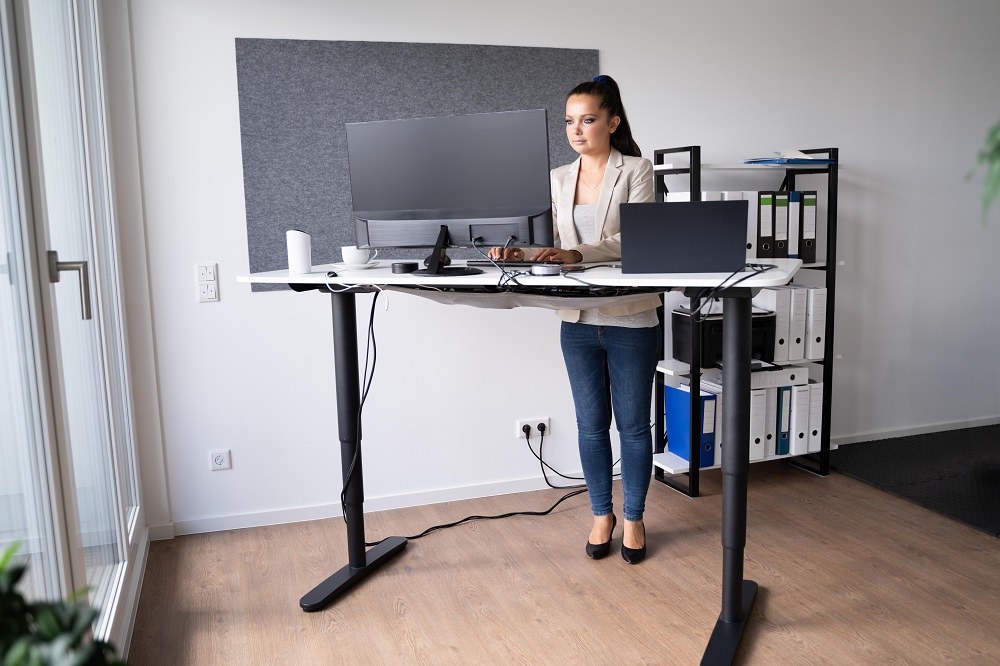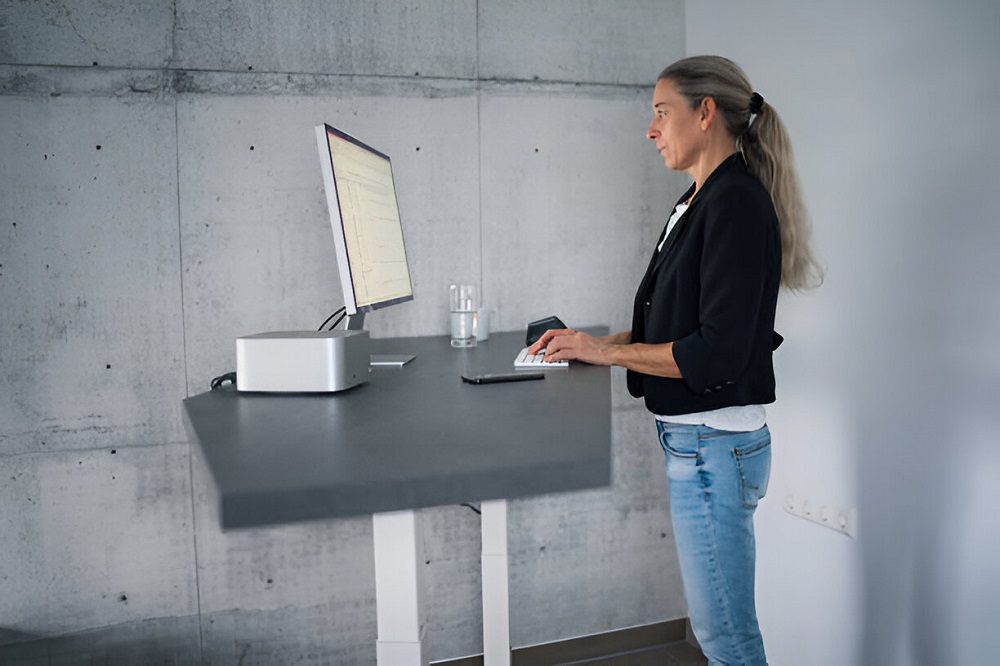Most of the people today spend a significant portion of their workday hunched over traditional desks. This static posture can wreak havoc on our bodies, which leads to aches, pains, and even long-term health problems.
A common option that promises a more ergonomic & healthy way to work is the standing desk. However, just having a standing desk is not enough. The key to unlocking its full potential lies in finding the perfect height. But how will you find the proper height for standing desk? How is it different from a regular desk? Let’s just understand all this in detail!
Why Does Proper Standing Desk Height Matter?
Maintaining a good posture is key for overall health and well-being. When using a standing desk at the wrong height, then that means you are introducing the risk of new postural strains.

Here’s how an improperly adjusted standing desk can impact your body:
- Neck and Shoulder Pain: When you type with your elbows raised or lowered excessively, your shoulders and neck must adjust, which can cause strain and discomfort.
- Back Pain: Your lower back is put under unnecessary strain when you slouchor crouch over a high desk.
- Wrist Problems: Improper wrist position due to an incorrect desk height can contribute to carpal tunnel syndrome and other repetitive strain injuries.
Studies support the importance of regular desk height. According to a 2018 research review which was published in the journal Applied Ergonomics, utilizing a standing desk with the wrong height adjustment can counteract any possible advantages and possibly cause the development of new musculoskeletal conditions.
On the other hand, a standing desk that is properly set can greatly enhance your working environment. Here are a few advantages:
- Improved Posture: Standing upright promotes better spinal alignment, reducing back pain and discomfort.
- Increased Blood Flow: Standing all day long might increase circulation, which will increase energy and sharpness.
- Reduced Risk of Health Problems: Standing desks may help in reducing the risk of heart disease, obesity, & type 2 diabetes, according to studies.
Regular Desk Height vs. Standing Desk Height: Understanding the Differences
The height range for conventional, non-adjustable workstations is normally between 28" and 30" inches from the floor. This height is designed to support typing when seated, with the elbows comfortably resting at a 90-degree angle.

On the other hand, a much broader height range—typically between 25" and 50" inches—is available with standing desks. This enables personalized adjustments to guarantee optimal standing ergonomics.
| Features | Regular Desk | Standing Desk |
| Height Range | 28" - 30" | 25”-50” |
| Intended Posture | Seated | Standing |
| Focus on Ergonomics | Limited | Adjustable |
| Benefits | Designed for comfort while seated | Promotes improved posture, increased blood flow, and potentially reduces risk of chronic health problems |
| Adjustability | Fixed Height | Adjustable height allows for personalized ergonomic setup |
| Suitability | Ideal for tasks requiring extended periods of seated work | Ideal for those who want to alternate between sitting and standing throughout the workday. |
Here are some of the key points that one should consider-
- Standard desk heights are intended for users who are between 5'10" and 6'0". Users who are not in this range could find a regular desk uncomfortable.
- Standing desks provide a greater range of adjustment to suit users of different heights and guarantee the right elbow alignment for typing.
- Regular desks usually don't have the adjustable keyboard trays that standing desks do, making them less suitable for the best possible ergonomic positioning.
Finding Your Perfect Standing Desk Height: A Step-by-Step Guide
Now that you understand the necessity of proper standing desk height, let's dive into the steps to personalize your workspace and know what is standard desk height-
Step 1: Measure Yourself
The first step in this procedure is figuring out how high your elbow should be while standing. This is what you must do:
- Stand tall with your back straight against a wall.
- Let your arms lie loosely by your sides & relax your shoulders.
- Bend your elbows at a 90-degree angle, which ensures your forearms are parallel to the floor..
- Anyone who can measure the distance between the floor and the bend in your elbow is welcome to do so. This measurement shows you where to set your desk so that you can type comfortably with your elbows bent.
Step 2: Consider Additional Factors
While elbow height provides a solid starting point, other factors can influence your ideal desk setup:
- Monitor Height- Your monitor should be positioned such that your gaze naturally falls at the top third of the screen. If you use a monitor stand, adjust the standing desk height accordingly to maintain this comfortable viewing angle.
- Keyboard Tray- If your keyboard is contained in a separate tray, be sure it can be adjusted so that, when typing, your elbows remain 90 degrees bent. This encourages appropriate arm placement and reduces wrist strain.
- Footrest- It is especially advantageous to use a footrest when standing for extended periods of time. When adjusting your standing workstation, take into account the height of your footrest. When using the footrest, your knees should ideally be slightly bent.
Step 3: Experiment and Fine-Tune
Once you have determined your baseline height based on your elbow measurement and factored in additional considerations, it's time to experiment!
- Adjust your standing desk to the calculated height.
- Stand at your desk and pay attention to how your body feels.
- Look for signs of discomfort like neck, shoulders, or back pain. Difficulty maintaining good posture or straining to reach the keyboard or mouse could also be indicators of an incorrect height.
Step 4: Make Adjustment
Adjust your workstation height by taking into account what you acquired in step 3. Remember, small adjustments can make a big difference. Here are some additional tips:
- Start with short standing intervals- If you are new to standing desks, begin with short periods (20-30 minutes) throughout the workday, gradually increasing the duration as your body adjusts.
- Alternate between sitting and standing- It is best to keep your work style dynamic. Invest in a cozy, adjustable chair so you may change positions over the day.
- Listen to your Body- Pain is a warning to change course. Adjust your desk height as needed until you are in a comfortable position.
Conclusion
Finding the perfect standing desk height is an individual journey. You can design an ergonomic office that encourages comfort and productivity by following this step-by-step plan, paying attention to your body's feedback, and making adjustments as necessary.
Remember, a properly adjusted standing desk can be a robust tool for enhancing your overall well-being at work.




